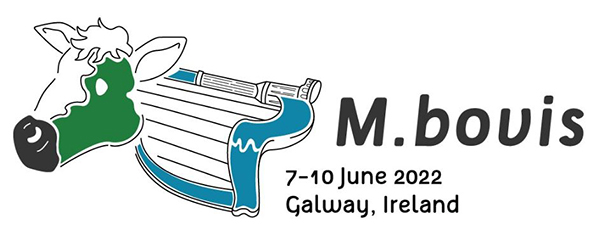June, 2022 news
June 30th, 2022
Via publiDB

VIII VETINDOC - VI PhDay Complutense
Communications in this event:
- Nuevos hallazgos en la patogenia y transmisión de Brucella pinnipedialis en cetáceos
- Come Fly with Myc: MALDI-TOF para el diagnĂłstico de micobacteriosis animales
June 30th, 2022
Vía animalshealth.es
Lina Mur, Premio Joven Talento: El veterinario español vale muchĂsimo y estamos muy bien formados
Premio Lina Mur
La veterinaria española Lina Mur, del equipo de Sanidad Animal de la EFSA, fue galardonada con el Premio Joven Talento en los Premios Salud Animal de España que organiza Animal’s Health…
June 28th, 2022
Vía diarioveterinario.com
Los investigadores españoles más influyentes en diferentes áreas de la Veterinaria
Investigadores influyentes en Veterinaria
Varios profesionales españoles figuran entre los primeros puestos de los rankings de Expertscape como los expertos más influyentes a nivel mundial en diferentes ámbitos de la sanidad animal…
June 24th, 2022
Via publiDB
Identifying high-risk areas for dog-mediated rabies using Bayesian spatial regression
Investigation article published in One Health
Despite ongoing control efforts, rabies remains an endemic zoonotic disease in many countries. Determining high-risk areas and the space-time patterns of rabies spread, as it relates to epidemiologically important factors, can support policymakers and program managers alike to develop evidence-based targeted surveillance and control programs. In this One Health approach which selected Thailand as the example site, the location-based risk of contracting dog-mediated rabies by both human and animal populations was quantified using a Bayesian spatial regression model. Specifically, a conditional …
Read more
June 22nd, 2022
Via publiDB
Endometritis in breeding mares from Spain: microbial prevalence and antimicrobial susceptibility
Oral communication in 5th International Conference on Uterine Disorders in Farm animals: Endometritis as a cause of infertility in domestic animals
June 21st, 2022
Via publiDB

Environment and Offspring Surveillance in Porcine Brucellosis
Investigation published in Frontiers in veterinary science
Porcine brucellosis, caused by Brucella suis (B. suis), is a notifiable disease causing significant economic losses in production systems. Most infected pigs may act as carriers and shed B. suis even if asymptomatic. This can contribute to environmental persistence, thus hindering control efforts. Here, the environment and the offspring were investigated during and after a B. suis outbreak at a sow breeding farm. The diagnosis of B. suis in sows (n = 1,140) was performed by culture and polymerase chain reaction (PCR) from vaginal swabs, indirect enzyme-linked immunosorbent assay (I-ELISA) from…
Read more
June 21st, 2022
Via publiDB
A current global view of the asf situation
Conference in 26th international pig veterinary society congress. IPVS 2022
June 21st, 2022
Via publiDB
Visita al Centro VISAVET de la Universidad Complutense de Madrid
Oral communication in Agenda MisiĂłn CientĂfico TĂ©cnica UCM-LAIS/UFRN
June 21st, 2022
Via publiDB

I3S International Symposium Salmonella and Salmonellosis. 2022 edition
Communications in this event:
June 21st, 2022
Vía animalshealth.es
Españoles desarrollan nuevas vacunas orales contra las garrapatas en el ganado
Vacunas orales contra garrapatas
El Instituto de InvestigaciĂłn en Recursos CinegĂ©ticos ha ensayado con Ă©xito una vacuna oral en ganado bovino que combina antĂgenos de garrapata con micobacterias inactivadas…
June 18th, 2022
Via publiDB
La Hora Porcina con J. M. Sánchez VizcaĂno
Interview in Agrenews TV of Agrinews
June 17th, 2022
Via publiDB

XXXIII ReuniĂłn de la Sociedad Española de AnatomĂa PatolĂłgica Veterinaria
Communications in this event:
- Efecto protector de Mycobacterium bovis inactivado por calor frente a Leishmania
- Linfoma intestinal de células T (EATL-2) en una nutria asiática de uñas cortas (Aonyx cinereus)
- Grosspath 3D: Principales lesiones macroscĂłpicas de decomiso en matadero en tres dimensiones
- Brote por Aeromonas salmonicida en alevines de esturiĂłn siberiano (Acipenser baerii)
June 13rd, 2022
Via publiDB

Feline Gastrointestinal Eosinophilic Sclerosing Fibroplasia-Extracellular Matrix Proteins and TGF-β1 Immunoexpression
Veterinary sciences publish this investigation article
Feline gastrointestinal eosinophilic sclerosing fibroplasia (FGESF) has been described as an inflammatory disorder with an eosinophilic component with etiopathogenesis that is still unknown. Sixteen intestinal samples from two veterinary diagnostic services (2014–2017) were included in the study. A histopathological criterion classified the cases into three grades (mild, moderate, and severe) according to the distribution of the lesions and the course. An immunohistochemical study of collagen I, collagen III, fibronectin, and transforming growth factor β1 (TGF-β1) was performed in …
Read more
June 9th, 2022
Via publiDB

¿Está México preparado para la viruela del mono?
Interview in MĂ©xico of El PaĂs
Ante una cifra que supera las 700 personas infectadas en más de 20 paĂses no endĂ©micos, expertos descartan que esta zoonosis africana desemboque en pandemia…
Read more
June 9th, 2022
Via publiDB

Seventh International Conference on Mycobacterium bovis
Communications in this event:
- Advances in the antibody-based diagnosis of caprine tuberculosis: Milk as an alternative sample
- One Health and Bovine Tuberculosis: The Long and Winding Road
- The bTB eradication programme in Spain – the role of the EU Reference Laboratory
- P22 performance for TB serodiagnosis in multiple host species
- TB Macroscopical Lesions and Spoligotyping Signature: Is there a pattern?
June 6th, 2022
Via publiDB

Seminars VISAVET 2022
Communications in this event:
- ExperimentaciĂłn Animal. Congreso FELASA 2022
- When order matters: the importance of genome structure in V. cholerae
- Discussion on curricula development and research topics in fish pathology
- Nanotechnology basics in fish pathology
- Introduction in fish pathology
- Malaria anaemia: Understanding the pathogenesis, significance and impact of co-infection
June 1st, 2022
Via publiDB
Zoonotic Transmission of Diphtheria from Domestic Animal Reservoir, Spain
Investigation article published in Emerging Infectious Diseases
Toxigenic Corynebacterium ulcerans is as an emerging zoonotic agent of diphtheria. We describe the zoonotic transmission of diphtheria caused by toxigenic C. ulcerans from domestic animals in Spain, confirmed by core-genome multilocus sequence typing. Alongside an increasing number of recent publications, our findings highlight the public health threat posed by diphtheria reemergence.
Diphtheria has been increasing in relevance because of increasing individual travel and surges in mass relocation events of refugees, asylum seekers, and immigrants from countries where diphtheria remains endemi…
Read more
June 1st, 2022
Via publiDB
Potential for improved detection of bovine tuberculosis by targeting combined blood biomarkers in multi-test algorithms
Veterinary Immunology and Immunopathology publish this investigation article
Bovine tuberculosis (bTB) control programs can be improved by combined use of tests for humoral and cell-mediated immune responses targeting multiple biomarkers of Mycobacterium bovis. To further the diagnostic benefits of this approach, we used Dual Path Platform (DPP) technology to test sera from cattle with naturally acquired bTB in the United States (US) and Spain for the presence of M. bovis antigen, IgM and/or IgG antibodies to MPB70/MPB83 fusion antigen in conjunction with tuberculin skin tests (TST) or interferon-gamma release assays (IGRA). When TST was complemented with detection of …
Read more
June 1st, 2022
Via publiDB
Molecular detection of Tritrichomonas foetus in bovine samples: a novel real-time polymerase chain reaction (PCR) assay targeting EF1-alpha-Tf1 and a comparative study of published PCR techniques
Parasitology Research publish this investigation article
The parasite T. foetus causes trichomonosis in cattle but is generally asymptomatic in males. Thus, many bulls carrying the disease go unnoticed, making the detection of T. foetus in bulls an important aspect for its control. Due to drawbacks posed by its cultivation, PCR is a preferred option for diagnostic laboratories. Most published PCR protocols target the genomic region compring the 18S, 5.8S, and 28S rRNA genes and internal transcribed spacers 1 and 2 (rRNA-ITS region), homologous to that of other Tritrichomonas species. There is minimal information on alternative genetic targets and no…
Read more
June 1st, 2022
Via publiDB
Permeability of artificial barriers (fences) for wild boar Sus scrofa in Mediterranean mixed landscapes
Investigation article published in Pest management science
Background: Fences are one of the most widespread manmade features in nature, constituting an artificial limitation to the movement of wildlife. To date, their effects on wildlife behaviour have been understudied but this knowledge is required to design effective management procedures. Using 21 GPS-monitored wild boar, we evaluated the permeability of different types of fences and described temporal patterns and spatial hotspots for crossing events. A fence`s permeability was inferred by the crossing success, i.e., the number of times that animals crossed a barrier vs the number of times they …
Read more
June 1st, 2022
Via publiDB
Seguridad del candidato vacunal LV17/WB/RIE1 frente a la ppa en jabalĂes: sobredosis y dosis repetidas
New article published in Porcinews
La peste porcina africana (PPA) es una enfermedad infecciosa altamente letal que afecta a los cerdos domĂ©sticos y a los jabalĂes, estando su control dificultado por
la falta de un tratamiento o vacuna eficaz. Teniendo en cuenta el importante papel
del jabalĂ en la propagaciĂłn del virus, la vacunaciĂłn oral de estos animales serĂa
una esperanza para hacer frente a este problema.
El presente estudio tuvo como objetivo evaluar la seguridad de un candidato vacunal (Lv17/WB/RIE1), con eficacia evaluada previamente, en tĂ©rminos de sobredosis (dosis alta) y dosis repetidas (revacunaciĂłn) e…
Read more


